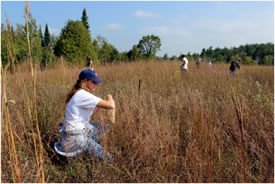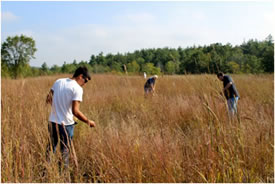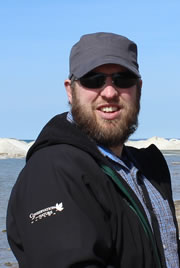Sowing the seeds of conservation: The importance of fall seed collection in native biodiversity protection

Fall seed collection on the Rice Lake Plains, ON (Photo by NCC)
As fall arrives on the Nature Conservancy of Canada’s (NCC’s) Rice Lake Plains properties, the colours change — not just the trees, but the grasses as well. Transforming from summer green to yellows and reds, this change heralds the fall seed collecting season.
Species mature at different times based on blooming schedules and weather conditions. For most species of tall grasses on the Rice Lake Plains, this means that fall is the best time for seed collection. This includes the stately big bluestem, golden Indian grass, tall and feathery panic grass and fluffy clumps of little bluestem.
These plants are some of the key species of the tall grass prairie. Once a more common sight, today less than one per cent of the original habitat survives. One of the ways to increase the range of rare habitat is to plant areas using seed collected from various plants on the property.

Volunteers lending a hand to collect seed on the Rice Lake Plains, ON (Photo by NCC)
Each year, we offer an event to get Conservation Volunteers on the property and help with the seed collection process. For me, this is one of the most enjoyable activities. It is easy to see the results of your efforts: a large bag of seed can be collected after just a few hours. This is a task that requires you to go at a relaxing pace, chat with other volunteers and soak in your surroundings while you escape into the world of the tall grass prairie. I like to share stories about the Rice Lake Plains and its natural history while we work.
The seeds of the prairie’s grasses and flowers vary in size, shape and texture. Indian grass seed is smooth like silk and enjoyable to collect. Some seeds are found at knee height while others species, like big bluestem, often require the picker to reach up to collect.
A group of volunteers can collect a large amount of seed in a very short amount of time. This is an immense help to our conservation biologists. All across the country, NCC hosts other fall seed collection events to help expand the range of our native habitat or restore other areas.
Once collected, the seed is either spread on-site or planted in a nursery to be planted the following spring. Just one year after collection, the seeds become seed-producing plants that will again further our restoration efforts. It's great to be an integral part of this restoration cycle and fulfilling to steward, protect and enhance this unique habitat and share this experience with volunteers and visitors.
Next fall, we'll be back with our bags, ready to begin the cycle once again.


